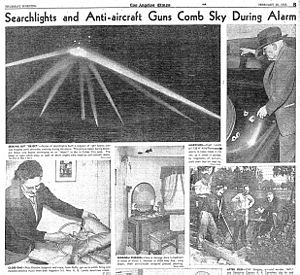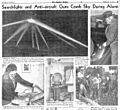Battle of Los Angeles facts for kids
| Part of the American Theater | |

Photos from Los Angeles Times, 26 February 1942
|
|
| Date | 24–25 February 1942 |
|---|---|
| Location | Los Angeles, California, U.S. |
| Deaths | 5 (3 in car accidents, 2 of heart attacks) |
The Battle of Los Angeles, also known as the Great Los Angeles Air Raid, was a strange event that happened during World War II. It took place in Los Angeles, California, from late February 24 to early February 25, 1942. People thought Japanese planes were attacking the city, and the U.S. military fired many anti-aircraft guns into the sky.
This incident happened less than three months after the U.S. joined World War II. The U.S. entered the war because Japan had made a surprise attack on Pearl Harbor. The day before the Los Angeles event, a Japanese submarine had also fired shells near Santa Barbara, California. After the "attack" in Los Angeles, the Secretary of the Navy, Frank Knox, said it was a "false alarm." But many newspapers at the time wondered if the government was hiding something. Later, officials said the whole event was likely caused by a lost weather balloon and people being very nervous because of the war.
Contents
Why Were People So Scared?
After the Imperial Japanese Navy attacked Pearl Harbor in Hawaii on December 7, 1941, the United States joined World War II. This made people across the country, especially on the West Coast, very worried. They feared that Japan might attack or even invade the U.S. mainland.
How Did War Nerves Spread?
Rumors and fears spread quickly. In Juneau, Alaska, people were told to cover their windows at night for a blackout. This was because of rumors that Japanese submarines were nearby. In Oakland, California, schools closed and a blackout was ordered after people heard a Japanese aircraft carrier might be off the coast. Police cars used civil defense sirens, and all radios had to be silent. Seattle also had a blackout. Some people even smashed businesses that left their lights on.
Protecting Important Places
The U.S. Army took these rumors seriously. About 500 soldiers moved into the Walt Disney Studios in Burbank, California. They were there to protect the famous Hollywood studio and nearby factories from enemy sabotage or air attacks.
Attacks on Ships and the Coast
As the U.S. got ready for war, anti-aircraft guns were set up, and air raid drills became common. Many American merchant ships were attacked by Japanese submarines off the West Coast. This happened from late 1941 to early 1942. These attacks made people even more nervous.
On February 23, 1942, a Japanese submarine surfaced near Santa Barbara, California. It fired shells at the Ellwood Oil field. The damage was small, but this attack made West Coast residents believe that Japanese forces could land on their beaches at any moment.
The Night the Alarms Rang
On February 24, 1942, the Office of Naval Intelligence warned that an attack on California could happen within ten hours. That evening, people reported seeing many flares and blinking lights near defense factories. An alert was called at 7:18 pm, but it was lifted a few hours later.
What Happened in the Early Morning?
Activity started again early on February 25. Air raid sirens blared across Los Angeles County at 2:25 am. A total blackout was ordered, meaning all lights had to be turned off. Thousands of air raid wardens went to their posts.
At 3:16 am, the 37th Coast Artillery Brigade began firing machine guns and anti-aircraft shells into the sky. They fired at what they thought were enemy planes. More than 1,400 shells were fired in total. Pilots were ready, but their planes stayed on the ground. The firing stopped around 4:14 am. The "all clear" signal was given, and the blackout ended at 7:21 am.
Aftermath of the Firing
Some buildings and cars were damaged by falling shell pieces. Sadly, five civilians died because of the anti-aircraft firing. Three people died in car accidents during the chaos, and two died from heart attacks caused by the stress. This event was big news across the West Coast and the entire country.
The Mystery of the UFO Photo
A photo published in the Los Angeles Times on February 26, 1942, has been used in UFO conspiracy theories. Some people say the photo clearly shows searchlights focused on an alien spaceship.
However, the photo was changed a lot before it was printed. This was a normal practice back then to make black and white photos look better. A writer from the Times, Larry Harnisch, pointed out that this changed photo was used in trailers for the 2011 movie Battle: Los Angeles. He said that if the movie wanted to make UFO research look like lies, it did a great job.
Remembering the Event
Every February, the Fort MacArthur Museum holds an event called "The Great LA Air Raid of 1942." This museum is located at the entrance to Los Angeles Harbor.
Images for kids
de:Angriffe auf Nordamerika während des Zweiten Weltkriegs#Falscher Alarm
See also
 In Spanish: Batalla de Los Ángeles (1942) para niños
In Spanish: Batalla de Los Ángeles (1942) para niños


